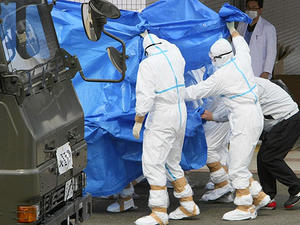Nuclear disastersNew report paints dire picture of Japanese Fukushima response
A new report reveals that last year’s nuclear crisis at Japan’s Fukushima Daiichi atomic energy plant was dangerously close to spiraling out of control as senior officials bickered internally, lacked critical information on the extent of the damage, and covertly considered the possibility of evacuating Tokyo

Workers at the Fukushima plant working to contain the meltdown // Source: orf.at
A new report reveals that last year’s nuclear crisis at Japan’s Fukushima Daiichi atomic energy plant was dangerously close to spiraling out of control as senior officials bickered internally, lacked critical information on the extent of the damage, and covertly considered the possibility of evacuating Tokyo.
The New York Times, which obtained an advance copy of the study, reports that according to the investigation, senior government officials, the manager of Fukushima nuclear plant, and Tokyo Electric Power (Tepco), the plant’s operator, had crippling communication breakdowns and did not trust each other.
This internal bickering impeded response efforts and at times resulted in the release of contradictory information.
“We barely avoided the worst-case scenario, though the public didn’t know it at the time,” Funabashi said in an interview with the Times.
In the early stages of the crisis, the plant manager, Masao Yoshida, was frantically calling top officials in Prime Minister Naoto Kan’s administration assuring them that he could contain the incident if he was allowed to keep workers in place and ignore orders from Tepco to not use sea water to cool the rapidly overheating reactors.
At the same time, Tepco president Masataka Shimizu was working against Yoshida, making conflicting calls to Kan’s office arguing that the facility needed to evacuate its entire staff, a potentially catastrophic move.
According to the report, if all of Fukushima Daiichi’s employees were evacuated, the plant would have continued to degrade resulting in the release of even greater quantities of radioactive material, which would then force the evacuation of other nuclear facilities nearby and cause more meltdowns.
Yukio Edano, the chief cabinet secretary at the time, warned that such a “demonic chain reaction” of plant meltdowns could force the evacuation of Tokyo, 150 miles to the south.
“We would lose Fukushima Daini, then we would lose Tokai,” Edano said in reference to two other nuclear facilities. “If that happened, it was only logical to conclude that we would also lose Tokyo itself.”
Furthermore the report details the anxiety of the Kan government over their lack of knowledge about the status of the more than 10,000 spent fuel rods stored near the damaged reactors. With the cooling systems damaged and a series of hydrogen explosions rocking the facility, senior officials feared the relatively unprotected storage pools could release even more radiation.
The fate of the storage pools was unknown for five days, until a Japanese military helicopter was eventually able to confirm that the pool at greatest risk was still safely filled with water.
Speaking to the Times, Funabashi criticized the Kan administration for purposely downplaying the seriousness of the nuclear accident and hiding critical information from its citizens as well as the United States.
Funabashi said in the early stages of the nuclear crisis, the U.S –Japan relationship was quite “precarious,” until the two countries instituted daily meetings on beginning 22 March.
The report acknowledged that the Japanese government had not fully disclosed details about the potential dangers of the Fukushima incident, but also blamed the United States for overstating the risks. As evidence, the investigation points to when U.S. officials incorrectly warned that the spent fuel rods in the storage pool at greatest risk were exposed to air, in danger of melting down, and releasing large amounts of radiation.
Ultimately, though, the 400-page report pins the blame on the Japanese government for its failure to properly warn residents of the potential danger the accident posed, which resulted in deep-seeded mistrust between the Japanese people and the government. These feelings of distrust spurred the independent investigation, which is rare in Japan where the public often accepts official versions of events.
The investigation, led by the Rebuild Japan Initiative Foundation, had unprecedented access to Japan’s top nuclear regulators and government officials including Naoto Kan, the prime minister at the time. Headed by Yoichi Funabashi, the former editor in chief of the Asahi Shimbun and one of Japan’s most respected thought leaders, the foundation interviewed more than 300 people.
The report, completed by thirty lawyers, journalists, and university professors, is set to be released later this week.
